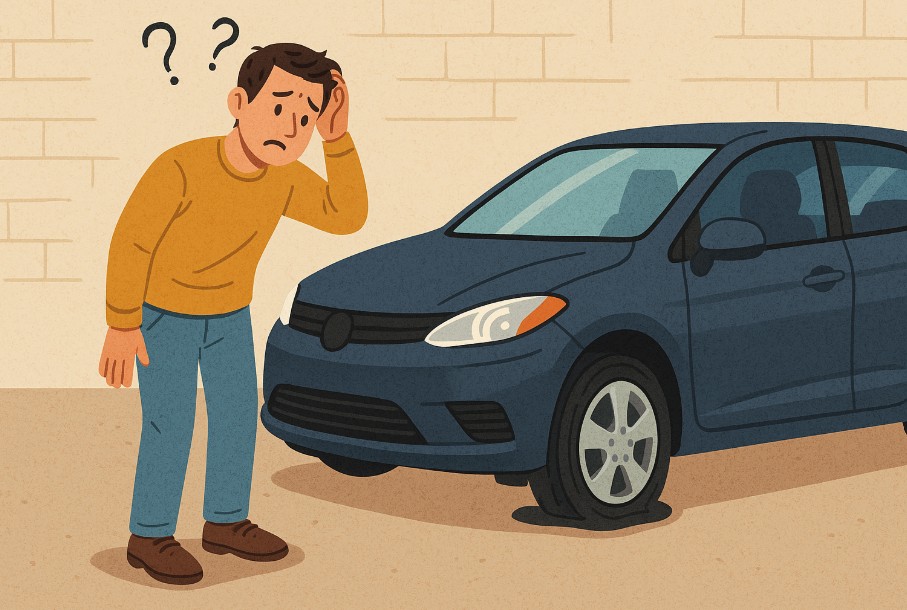Why is My Tire Pressure Light Still on After Filling Tires?
You’ve just filled your tyres, checked the pressure, and yet the warning light remains stubbornly lit on your dashboard. This common issue puzzles many drivers and can be both frustrating and concerning.
Understanding why the tyre pressure warning light stays on after inflating your tyres is essential for maintaining both safety and vehicle performance.
There are a variety of causes ranging from environmental factors to technical malfunctions within the tyre pressure monitoring system (TPMS).
In this guide, we’ll explore everything you need to know to diagnose, fix, and prevent this issue, giving you peace of mind on every journey.
What Is a Tyre Pressure Monitoring System?
A Tyre Pressure Monitoring System (TPMS) is an electronic safety feature designed to alert you when your tyres are under-inflated.
This system ensures you’re aware of low tyre pressure before it becomes a hazard. There are two types of TPMS: direct and indirect. Direct TPMS uses sensors inside each tyre to measure air pressure in real-time.
These sensors transmit data to your vehicle’s onboard computer. Indirect TPMS, on the other hand, estimates tyre pressure using wheel speed sensors tied to the anti-lock braking system.
The dashboard warning light is triggered when one or more tyres fall below the manufacturer’s recommended pressure levels. Modern systems may even show you which tyre is affected and its current pressure. While TPMS is highly reliable, it isn’t foolproof.
Faulty sensors, battery issues within the sensor units, or environmental changes like temperature drops can affect accuracy.
Regular TPMS checks and recalibration, especially after tyre replacements or pressure changes, are important for keeping your system responsive and precise.
Why Is Proper Tyre Pressure Important for Safe Driving?

Maintaining the correct tyre pressure is critical for your safety, fuel efficiency, and the overall lifespan of your tyres.
Tyres that are either over or under-inflated can lead to poor vehicle handling and longer stopping distances. Under-inflation causes the tyre to flex more, generating excessive heat and increasing the risk of a blowout.
Over-inflation, conversely, can reduce the tyre’s contact with the road, leading to diminished grip and uneven wear.
Benefits of Correct Tyre Pressure
- Enhanced fuel efficiency due to reduced rolling resistance
- Safer handling and more responsive braking
- Longer tyre life with even tread wear
- Lower chances of tyre-related breakdowns
In the UK, weather conditions and seasonal temperature changes often cause fluctuations in tyre pressure, which is why regular checks are essential.
A simple monthly inspection or checking before long drives can make all the difference in maintaining vehicle safety and performance.
Most importantly, always refer to your vehicle’s handbook or the sticker located on the driver’s side door frame to find the correct pressure specifications.
What Are the Common Dashboard Warning Lights Related to Tyre Pressure?
Your vehicle’s dashboard is a communication hub that alerts you to various performance and safety issues, tyre pressure being a major one.
The most recognisable indicator for tyre pressure is the amber symbol resembling a horseshoe with an exclamation mark in the middle.
When this light appears, it generally means one or more of your tyres is under-inflated, but it doesn’t always specify which one unless your vehicle has an advanced display.
In addition to the tyre pressure warning light, other dashboard indicators can appear alongside it, including:
- ABS or Brake System Warning Light: May indicate TPMS integration issues
- Check Engine Light: Some vehicles tie certain TPMS sensor faults to the ECU
- Traction Control Light: Can be linked to uneven tyre pressure affecting grip
It’s important not to ignore these signals, as they may point to a broader problem, such as a TPMS sensor malfunction or wheel speed discrepancy.
If you see multiple lights in combination, it’s advisable to have your vehicle diagnosed by a professional to avoid safety hazards or unnecessary tyre wear.
Why is My Tire Pressure Light Still on After Filling Tires?
After inflating your tires to the recommended pressure, you may expect the warning light to disappear, but that doesn’t always happen. Several factors can cause the light to stay on, even after topping up your tires.
1. TPMS Sensor Has Not Recalibrated

Your car’s Tire Pressure Monitoring System (TPMS) may take some time to update after inflating the tires.
The system often requires a short drive at moderate speed to recognize the new pressure levels. If the light remains on, manually resetting the TPMS through your vehicle’s settings may help.
How to Fix?
Drive for 10–15 minutes at speeds above 20 mph to allow the system to recalibrate. If the light persists, check your owner’s manual for the TPMS reset procedure.
Some vehicles require holding the reset button or using a diagnostic tool to clear the warning.
2. Uneven Pressure Between Tires

Even if all four tires are close to the recommended PSI, slight inconsistencies can still trigger the warning light.
TPMS sensors monitor differences between tires, so if one is slightly underinflated compared to the others, the system may not clear the alert. Ensuring consistent pressure across all tires is key.
How to Fix?
Use a digital tire gauge to verify that all tires are inflated to the exact recommended PSI. If needed, adjust pressure in each tire until they are evenly matched. Avoid relying solely on petrol station inflators, as they may not be precise.
3. Cold Weather Effects

A sudden drop in temperature can cause tire pressure to decrease, triggering the warning light even if you recently inflated them.
This is because cold air contracts, reducing PSI, especially overnight. The light may turn off as the tires warm up during driving.
How to Fix?
Check and refill your tires in the morning when they are cold, ensuring they match the recommended PSI. If the light persists, add a small amount of air to compensate for temperature fluctuations, but avoid overinflation.
4. Slow Puncture or Leak

A small nail, debris, or a minor leak can cause your tire to gradually lose air, making the light return shortly after filling.
These slow leaks may not be immediately visible but can worsen over time. Regularly checking for punctures can prevent unexpected pressure loss.
How to Fix?
Inspect the tire for visible punctures, leaks, or embedded objects. Apply soapy water around the tread and valve stem if bubbles form, there’s a leak.
For minor leaks, use a sealant or patch kit; for larger damage, visit a mechanic for professional repair.
5. Faulty TPMS Sensor

Aging or damaged TPMS sensors can send incorrect readings, causing the light to stay on even when tire pressure is normal.
These sensors typically last 5–10 years, but battery failure or sensor malfunction can lead to inaccurate pressure alerts. If none of the other solutions work, the sensors may need replacing.
How to Fix?
Have a mechanic run a TPMS diagnostic to check for sensor faults. If one or more sensors are faulty, they may need recalibration or replacement. Replacing TPMS sensors usually requires professional assistance, as they are built into the valve stems.
If your tire pressure light remains on despite addressing these issues, perform a manual TPMS reset using your car’s settings or consult a professional for further inspection. Regular maintenance and pressure checks can help prevent recurring warnings.
Could Cold Weather Be Triggering the Tyre Pressure Warning Light?
Yes, cold weather is one of the most common and natural causes of a tyre pressure warning light staying on especially in the UK’s fluctuating climate.
As the temperature drops, the air inside your tyres contracts, which lowers the pressure even if there’s no actual leak. This phenomenon can cause the TPMS to detect a pressure that’s below the threshold and activate the warning light.
This doesn’t necessarily mean there’s something wrong with your tyres. In many cases, the light turns on in the morning when it’s cold and turns off later in the day after the tyres have warmed up from driving.
However, it’s still advisable to check and top up the tyre pressure during cold spells, as regularly running on under-inflated tyres will increase wear and decrease fuel economy.
To prevent this issue, you can inflate your tyres slightly closer to the higher end of the recommended range during the winter.
Always follow the vehicle manufacturer’s guidelines when adjusting pressure due to seasonal changes.
How Can You Tell If the TPMS Sensor Is Faulty or Needs Resetting?

Identifying whether a TPMS sensor is faulty or simply needs resetting can help you avoid unnecessary tyre checks and costs.
While the warning light is meant to alert you to actual pressure problems, it can also indicate sensor issues.
Signs of a Faulty TPMS Sensor
- The warning light stays on after inflating and resetting tyres
- The light flashes for 60–90 seconds before staying solid
- Inconsistent readings across tyres even when pressures match
- The system fails to detect obvious changes in pressure
Common Reasons for TPMS Faults
- Sensor battery depletion (usually lasts 5–10 years)
- Physical damage during tyre replacement or repair
- Corrosion on valve stems or internal electronics
- Incorrect reset procedure after tyre service
If the light won’t turn off despite confirming correct pressure, it’s likely that one or more sensors need to be replaced or recalibrated.
You can visit a service centre with a TPMS diagnostic tool that identifies sensor health and battery levels, giving you accurate insight into whether a reset or replacement is required.
What Steps Should You Take to Manually Reset the Tyre Pressure Light?
If your tyre pressure warning light stays on even after inflating all tyres correctly, a manual reset may be necessary. Many vehicles require this step to recalibrate the TPMS system after any change in tyre pressure.
While some systems automatically reset after driving, others need a physical button press or a reset via the vehicle’s infotainment system.
How to Manually Reset Your TPMS?
- Step 1: Ensure all tyres, including the spare, are inflated to the correct pressure. Use a reliable digital gauge for accuracy.
- Step 2: Turn the ignition on without starting the engine.
- Step 3: Locate the TPMS reset button. This is often found beneath the steering wheel or in the glove box.
- Step 4: Press and hold the button until the warning light blinks three times.
- Step 5: Start the vehicle and drive at 20–30mph for at least 10 minutes to complete the recalibration.
For cars without a reset button, the process may be performed via the infotainment system or steering wheel controls.
Always consult your vehicle’s owner manual, as procedures vary depending on the make and model.
If the light still won’t turn off, the issue may lie within the sensors or the system itself, requiring diagnostics by a mechanic.
Can Driving After Tyre Inflation Help the System Recalibrate?

Yes, in many cases, simply driving the vehicle after inflating the tyres can prompt the TPMS to recalibrate and turn off the warning light.
Most modern vehicles with automatic TPMS do not require a manual reset if the system detects that all tyres are now within the recommended pressure range.
After inflating your tyres:
- Drive for at least 10 to 15 minutes at a consistent speed above 20mph.
- Avoid frequent stops or idling during this period to allow the system to gather sufficient pressure data.
- Make sure all tyres are equally inflated, as uneven pressures can confuse the TPMS.
This drive allows the TPMS sensors to reassess the pressure and communicate updated data to the vehicle’s computer.
However, if the warning light doesn’t turn off after this process, it could be a sign that the pressure in one tyre is still slightly off or that a sensor is malfunctioning. Always confirm tyre pressures with a calibrated digital gauge before driving to ensure accuracy.
How Do Seasonal Temperature Changes Affect Tyre Pressure Long-Term?
Seasonal temperature fluctuations have a significant impact on tyre pressure, especially in climates like the UK where temperature shifts are common throughout the year.
As temperatures drop, the air inside your tyres contracts, which reduces pressure. For every 10°C decrease in ambient temperature, tyre pressure can fall by approximately 1 PSI.
This means even if your tyres were perfectly inflated in summer, by winter they could be under-inflated.
Conversely, rising temperatures in spring or summer can lead to over-inflation if tyres were filled during colder months. Over-inflation can result in a harsh ride and uneven tyre wear.
To maintain proper tyre health year-round:
- Check tyre pressures at least once a month and before long trips.
- Always measure pressure when tyres are cold, as heat from driving raises pressure readings.
- Adjust pressures according to the seasonal recommendations found in your vehicle manual.
Neglecting seasonal adjustments can shorten tyre lifespan, reduce handling, and trigger the TPMS unnecessarily.
What Preventative Measures Can Help Avoid TPMS Issues in the Future?

Preventing TPMS issues begins with consistent maintenance and awareness of your vehicle’s needs. By taking proactive steps, you can avoid false warnings, improve road safety, and extend the life of both your tyres and sensors.
Key Preventative Measures
- Regular tyre pressure checks: Use a high-quality digital gauge to check pressures monthly.
- Check after weather changes: Especially after cold spells or heatwaves.
- Inspect valve stems and caps: Damaged valves can cause leaks and affect sensor accuracy.
- Avoid hitting kerbs or potholes: Sudden impact can damage internal sensors.
- Replace sensors during tyre changes: If sensors are old (typically over 5 years), it’s cost-effective to replace them alongside new tyres.
- Use nitrogen instead of air (optional): Nitrogen is less affected by temperature swings, helping pressure remain stable.
- Follow vehicle-specific reset procedures: Refer to your manual after each tyre inflation or rotation.
Many TPMS issues can be traced back to irregular maintenance or failing to respond to early warning signs.
Staying ahead with preventive habits ensures the system continues to function reliably, giving you the confidence to drive without unnecessary alerts.
Conclusion
When your tyre pressure warning light stays on after you’ve already filled your tyres, it can be more than just a minor nuisance.
From environmental changes like cold weather to technical faults in the TPMS sensors, a variety of reasons could be at play.
Understanding how your TPMS works, how to manually reset it, and what to look for in terms of wear and leaks can help you resolve the issue efficiently.
Taking a proactive approach to tyre maintenance doesn’t just turn off a dashboard light it ensures safer driving, better fuel economy, and longer-lasting tyres.
Whether it’s recalibrating the system through a reset or scheduling regular pressure checks, small efforts go a long way.
Don’t ignore that warning light; let it be a reminder to stay one step ahead of tyre trouble. With proper care and attention, you can keep your vehicle in top condition all year round.
Frequently Asked Questions (FAQs)
How do I check if my tyres are accurately inflated at home?
You can use a digital tyre pressure gauge for a precise reading and compare it to the manufacturer’s recommended pressure found in your car manual or door frame.
Can I disable the TPMS system permanently?
While technically possible in some vehicles, disabling TPMS is not recommended and may be illegal in the UK due to safety regulations.
Is it legal to drive with the tyre pressure light on in the UK?
It is not illegal to drive, but it could fail an MOT test, and driving with under-inflated tyres poses a safety risk.
What are signs of a slow puncture besides the warning light?
You might notice the car pulling to one side, reduced fuel economy, or visibly sagging tyres even after inflation.
Should I replace all TPMS sensors at once?
If one sensor fails and others are the same age, replacing all can be cost-effective since sensor batteries often expire around the same time.
Do all cars in the UK come with TPMS by default?
All new vehicles registered in the UK from November 2014 onwards are required to have TPMS as standard equipment.
How much does it cost to fix a faulty TPMS sensor?
On average, replacing a TPMS sensor in the UK can cost between £50 and £120, depending on the vehicle make and model.







